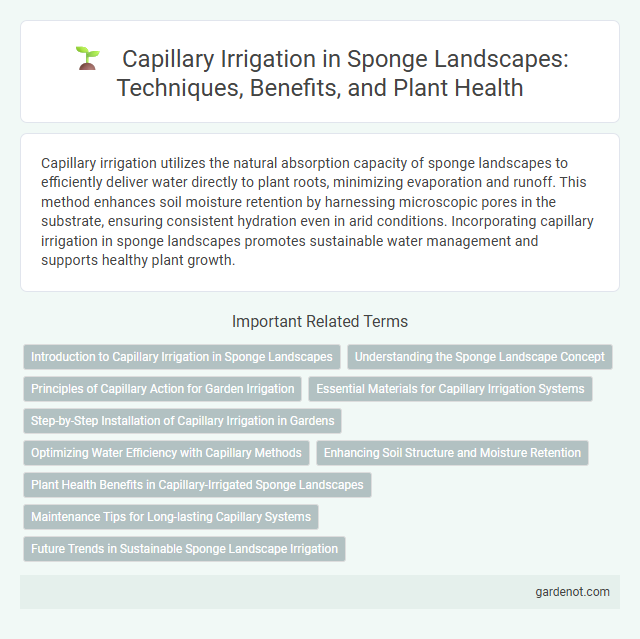Capillary irrigation utilizes the natural absorption capacity of sponge landscapes to efficiently deliver water directly to plant roots, minimizing evaporation and runoff. This method enhances soil moisture retention by harnessing microscopic pores in the substrate, ensuring consistent hydration even in arid conditions. Incorporating capillary irrigation in sponge landscapes promotes sustainable water management and supports healthy plant growth.
Introduction to Capillary Irrigation in Sponge Landscapes
Capillary irrigation in sponge landscapes utilizes the natural absorption and retention properties of porous soils to deliver water efficiently to plant roots. This method reduces water loss through evaporation and promotes optimal moisture distribution in the soil profile. By leveraging soil capillarity, sponge landscapes maintain sustainable hydration, enhancing plant growth and resilience in urban green infrastructures.
Understanding the Sponge Landscape Concept
Capillary irrigation in sponge landscapes leverages the natural soil porosity and moisture retention to enhance water distribution directly to plant roots. This method relies on the sponge-like properties of the soil, which absorb and hold water, gradually releasing it through capillary action to support vegetation during dry periods. Understanding this mechanism is crucial for optimizing water use efficiency in agroforestry and sustainable land management within sponge landscape ecosystems.
Principles of Capillary Action for Garden Irrigation
Capillary irrigation relies on the principle of capillary action, where water moves through narrow spaces in soil or porous materials without external force. This natural process enables efficient water distribution to plant roots by drawing moisture upward from a water reservoir through tiny soil pores. Maintaining optimal soil texture and moisture levels enhances the effectiveness of capillary irrigation in sponge landscape systems.
Essential Materials for Capillary Irrigation Systems
Essential materials for capillary irrigation systems include highly absorbent substrates such as coconut coir, peat moss, and vermiculite that enable effective water retention and gradual release to plant roots. Capillary mats made of polyester or polypropylene fibers facilitate uniform water distribution across the sponge landscape. Additionally, durable tubing, precise emitters, and moisture sensors ensure efficient water delivery and optimize irrigation schedules in capillary-based landscaping.
Step-by-Step Installation of Capillary Irrigation in Gardens
Capillary irrigation installation in gardens begins with selecting suitable porous materials like fabric or clay pipes that efficiently deliver water directly to plant roots. Next, lay these materials evenly beneath the soil surface in planting beds, ensuring proximity to root zones to maximize moisture absorption and reduce evaporation. Finally, connect the system to a water source with a pressure regulator to maintain consistent flow, followed by testing and adjusting flow rates for optimal garden hydration and water conservation.
Optimizing Water Efficiency with Capillary Methods
Capillary irrigation utilizes the natural upward movement of water through soil pores to deliver moisture directly to plant roots, minimizing evaporation and runoff. This method enhances water efficiency by reducing the volume of water applied while maintaining consistent soil moisture levels, making it ideal for sponge landscapes designed to maximize water retention and support drought-resistant vegetation. Integrating capillary irrigation with porous soil media further optimizes water conservation and promotes sustainable landscape management.
Enhancing Soil Structure and Moisture Retention
Capillary irrigation improves soil structure by promoting the formation of stable soil aggregates that enhance aeration and root penetration. This irrigation method ensures consistent moisture availability within the root zone, reducing evaporation and increasing water retention efficiency. Enhanced soil moisture retention supports healthier plant growth and resilience, critical for sponge landscape systems designed to optimize water use and sustainability.
Plant Health Benefits in Capillary-Irrigated Sponge Landscapes
Capillary irrigation in sponge landscapes enhances plant health by ensuring consistent moisture availability directly to root zones, reducing water stress and promoting robust root development. This method minimizes surface evaporation and nutrient leaching, maintaining optimal soil aeration and nutrient uptake essential for plant vitality. Improved water retention in sponge landscapes supports resilient plant growth, particularly in drought-prone urban environments, by stabilizing microclimates and reducing heat stress.
Maintenance Tips for Long-lasting Capillary Systems
Regularly inspect the capillary irrigation lines for clogs or algae buildup to ensure consistent water flow and prevent root rot in sponge landscape systems. Flushing the system with clean water every few weeks helps remove sediment and maintains the efficiency of water distribution. Use filtered water and avoid fertilizers with high salt content to prolong the lifespan of the capillary tubes and maintain optimal soil moisture levels.
Future Trends in Sustainable Sponge Landscape Irrigation
Capillary irrigation technology in sponge landscape designs is advancing towards integrating smart sensors and AI-driven water management systems to optimize moisture levels while minimizing water use. Future trends emphasize sustainable use of recycled water and enhancing soil permeability with biochar and hydrogels to improve capillary action efficiency. These innovations aim to create resilient urban green spaces that conserve water resources and support ecological balance.
Capillary irrigation Infographic

 gardenot.com
gardenot.com